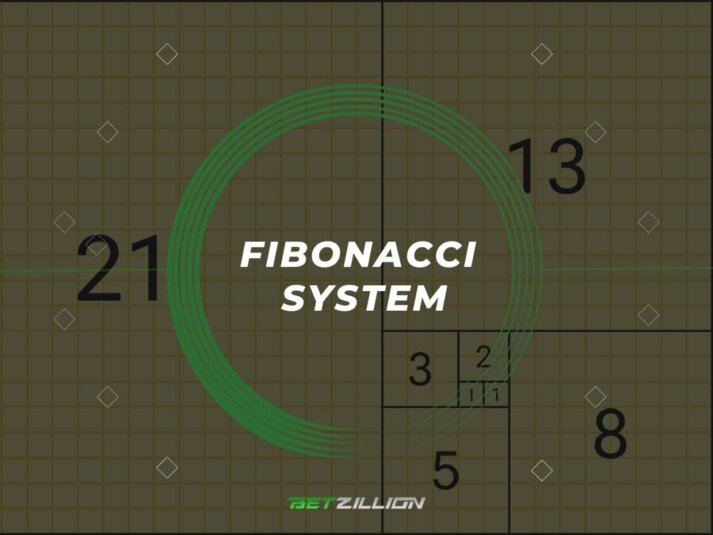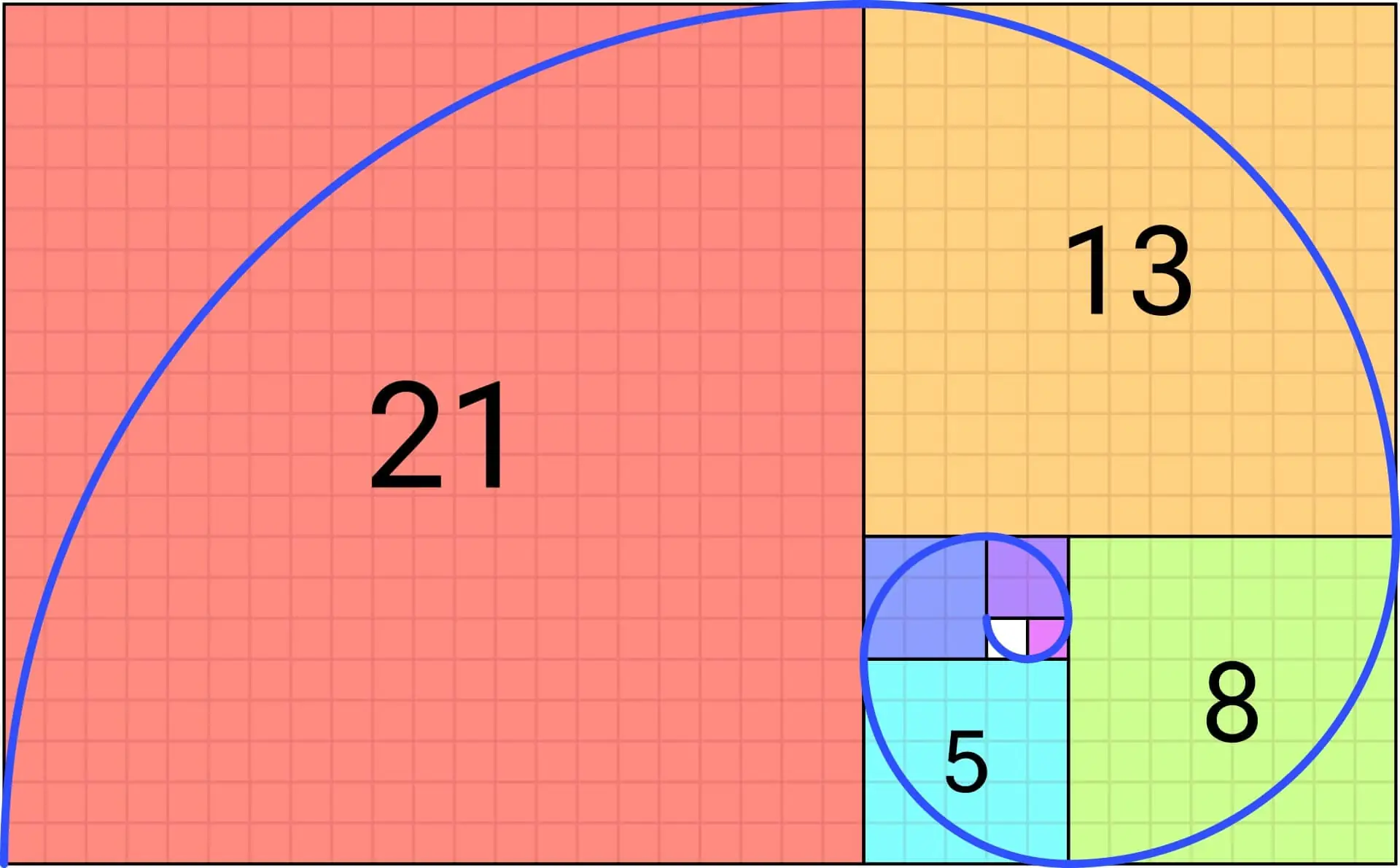Fibonacci Betting System

The Fibonacci betting system is a strategy based on a mathematical theory that uses a sequence of numbers to determine your stakes. And professional bettors often use it to manage losses and increase their chances of making a profit over time. In this guide, I’ll cover how this system works, its pros and cons, and whether it’s your ideal strategy.
How Does the Fibonacci Sequence Work?
The Fibonacci strategy works like any other negative progression betting system. The basic idea involves increasing your stake with each losing bet and reducing it as you win. This system is based on the Fibonacci sequence, which looks like this: 0, 1, 1, 2, 3, 5, 8, 13, 21, 34, 55, 89, 144. Each number in this sequence is the sum of the two previous ones.

Wikipedia.org: The Fibonacci Spiral
Fibonacci System Examples
Taking a cue from the sequence described above, your typical betting unit when using the Fibonacci system is 1. The steps below describe an example of the strategy in action.
- Place your first wager:
Let’s assume your one betting unit is $10, so you place your first wager with a $10 stake.
- Move up the sequence on a loss:
If you lose the $10 wager, you move to the next number in the sequence, which is still 1. Hence, your next stake is still $10. Let’s say you lose this second $10 stake again, so you move to the next number in the Fibonacci betting progression. Hence, your next stake is now $30.
- Move back two steps on a win:
Let’s say you are fortunate enough to win your $30 wager. In that case, you have to move two steps down the sequence. So, your next stake amount is $10, and so on.
Tips for Using the Fibonacci System
It’s important to mention that the Fibonacci method is designed primarily for games of chance with a 50/50 probability or close to it. A good example of where it is viable is baccarat or the red/black wager in roulette. While the strategy can also be applied to sports betting, it is not as ideal and effective. The outcomes of sports wagers are subject to various variables, and odds are rarely 50/50.
Another Fibonacci sports betting rule is that the system does not consider your bankroll limit. If you suffer a long losing streak and run through your bankroll, then there is no way to increase your stake amount further.
Below are some other useful tips to consider when using the Fibonacci wagering system:
- Look for wagers with the lowest house edge
- Bet low stakes to avoid hitting your bankroll limit
- Set realistic expectations
- Take advantage of sportsbook or casino bonuses
Fibonacci Betting System Pros & Cons
The Fibonacci betting strategy comes with both benefits and drawbacks. Let’s examine its pros and cons below:
| PROS | CONS |
|---|---|
|
PROS
|
CONS
|
Alternatives to the Fibonacci Sequence for Betting
If you decide that the Fibonacci sequence is not for you, several other betting strategies should be considered. For easier comprehension, I have grouped these alternatives into positive and negative progressive systems.
Negative Progressive Systems
As I explained earlier, negative progressive systems are betting strategies where bettors increase their stake amounts as they lose. These methods aim to recoup losses and turn a profit in the long run. Let’s examine some examples below:
- D’Alembert System:
The D’Alembert is often referred to as the modified Fibonacci betting system due to the similarities between both strategies. The only difference is that in the D’Alembert system, you increase your stake by one unit instead of two when you lose. As such, it is a simpler and more conservative option.
- Martingale:
The Martingale is another negative progressive system that doubles your stake after each loss. The concept behind this strategy is that you will eventually recoup all your losses, provided you have an infinite bankroll.
- Labouchere System:
The Labouchere system is also based on increasing your stakes after losing wagers. However, it aims to recoup losses with multiple small wins instead of a single win. BetZillion`s strategists cover each of these systems in detail so that you can read more about them in “Betting Strategies.”
Positive Progression Systems
Positive progression systems are the opposite of the negative ones I discussed above. They are based on increasing your stake amount after a win and reducing it following a loss. Let’s consider some examples below:
- Paroli System:
You increase your stake by one unit after each win and return to the beginning (one unit) after three successive wins. For every loss, you also go back to a single unit stake.
- Oscar’s Grind:
The Oscar’s Grind betting system is a popular positive progression system that involves increasing your stake by one unit after each win. If you lose a wager, your stake remains the same. The sequence ends when you have made one unit of profit; then you start again. While it only helps grind out small wins, it is less riskier than Fibonacci.
History of the Fibonacci
Leonardo Fibonacci, a renowned Italian mathematician from Pisa, developed the Fibonacci sequence. He introduced the sequence to modern mathematics in his 1202 book, Liber Abaci (The Book of Calculation). And today, gambling enthusiasts have him to thank for the Fibonacci wagering system.

Wikipedia.org: A page of Fibonacci's Liber Abaci from the Biblioteca Nazionale di Firenze showing 13 entries of the Fibonacci sequence
Is the Fibonacci Betting System effective?
As I stated earlier, the Fibonacci betting strategy can help bettors recover losses and increase their chances of turning a profit over time. However, the system is designed for games of chance with probabilities as close as possible to 50-50, like roulette, baccarat, and coin toss. So, its application is limited when betting on sports, as you’ll rarely find odds close to the 50% threshold.
Also, the Fibonacci betting method is built on a flawed logic of unlimited budget. A long losing streak can make you run through your bankroll. When that happens, there’s no way to increase your stake and recover losses, making the system unsustainable.
Therefore, you can consider other betting system options from the alternatives I listed above. You can also try other sophisticated sports wagering methods, such as the Kelly Criterion betting strategy.





The Fibonacci betting strategy will help me in games with nearly even odds, but its reliance on an unrealistic assumption of unlimited funds makes it risky and unsustainable for long-losing streaks. For sports betting, more nuanced approaches like the Kelly Criterion are advisable to better manage bankroll and risk.
I like Fibonacci mainly because it really helps when it comes to risk management, as the system aims at minimizing losses by gradually increasing bets after a series of losses.
I highly recommend Fibonacci Betting System as it offers a refreshing and structured approach to managing bets, making it a fantastic choice for both novice and seasoned gamblers.